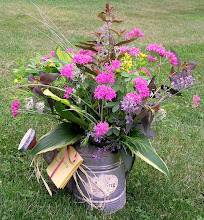 A garden can be a magical place filled with all kinds of amazing creatures. Over the past 13 years we have worked hard in our garden here in South Huntington to make it attractive to all the beautiful creatures around us.
A garden can be a magical place filled with all kinds of amazing creatures. Over the past 13 years we have worked hard in our garden here in South Huntington to make it attractive to all the beautiful creatures around us.Praying Mantis fill the gardens, the young praying mantis is hard to spot but the adults are quite large and are easier to see. Every year we will find one praying mantis in the butterfly bush under our kitchen window. They don't eat the pollen or the leaves on the butterfly bush, they eat the insects that are attracted to this bush.
 Butterflies will fly throughout the garden on a sunny day. There are many plants that grow well here on Long Island that will help attract and feed the butterflies. They always can be seen on the Liatris in our garden.
Butterflies will fly throughout the garden on a sunny day. There are many plants that grow well here on Long Island that will help attract and feed the butterflies. They always can be seen on the Liatris in our garden. Here's a butterfly on the butterfly bush! The botanical name for this bush is Buddleia davidii.
Here's a butterfly on the butterfly bush! The botanical name for this bush is Buddleia davidii. Bees are also beneficial insects in the garden. Without bees, we wouldn't have flowers, vegetables and all the other wonderful plant life. If you leave the bee alone, it won't sting you.
Bees are also beneficial insects in the garden. Without bees, we wouldn't have flowers, vegetables and all the other wonderful plant life. If you leave the bee alone, it won't sting you. Ants will also help spread pollen around. Can you see the ants climbing on the Bronze fennel flower?
Ants will also help spread pollen around. Can you see the ants climbing on the Bronze fennel flower? One thing many people don't realize is that you need to have plants that will feed caterpillars if you want to have butterflies in the garden. That means that some of your plants will be chewed upon but just imagine how beautiful the garden will be with those butterflies flying around.
One thing many people don't realize is that you need to have plants that will feed caterpillars if you want to have butterflies in the garden. That means that some of your plants will be chewed upon but just imagine how beautiful the garden will be with those butterflies flying around.
Not only do you have to have plants for the wildlife in your garden, you need to have water for them and you need to have an organic garden. By that, I mean that you should not use chemical products in your garden if you want to attract insects and wildlife.

Birds are creatures that we love to have in our garden. They eat many insects such as mosquitoes and they fill the air with the most wonderful sounds!
This photo shows a baby bird when it first flew out of it's birdhouse. Do you think it's asking the gnome "are you my mother"?

We are always so excited when we find a turtle in the garden. If we were putting chemicals on our lawn we might have nicer grass but we wouldn't have any of these cool creatures.

Some people don't like the rabbits in their garden because they eat the plants but how can you not love this adorable creature? If you don't use chemicals on your lawn, you will have lots of clover and the bunnies will eat the clover instead of your flowers.
 There's all kinds of things to see and do in your garden. We all think of gardening as planting seeds and flowers but you can do more than that. My daughter Emily used to love to go around the garden and photograph the creatures that she found.
There's all kinds of things to see and do in your garden. We all think of gardening as planting seeds and flowers but you can do more than that. My daughter Emily used to love to go around the garden and photograph the creatures that she found.One day she found a baby robin that had fallen out of a nest. We read that the mother bird would continue to care for it even though it was on the ground so we moved it to a part of the garden where it had some shelter from plant material.
Emily named the robin Einstein, can you tell why?
We continued to watch Einstein for many days and weeks and he grew up to be a beautiful robin.
This post has been written for Mrs. Diane Labate and the students at Maplewood Elementary school in South Huntington.













































